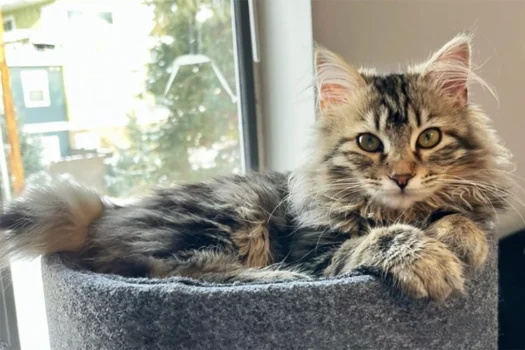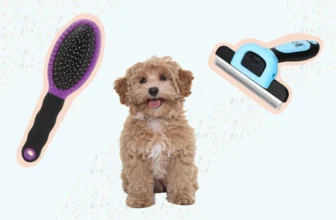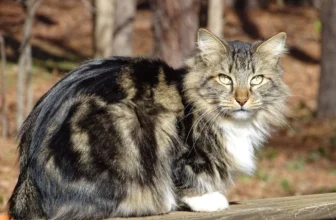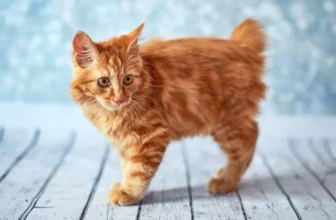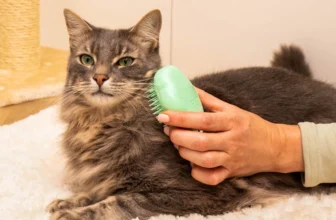Introduction
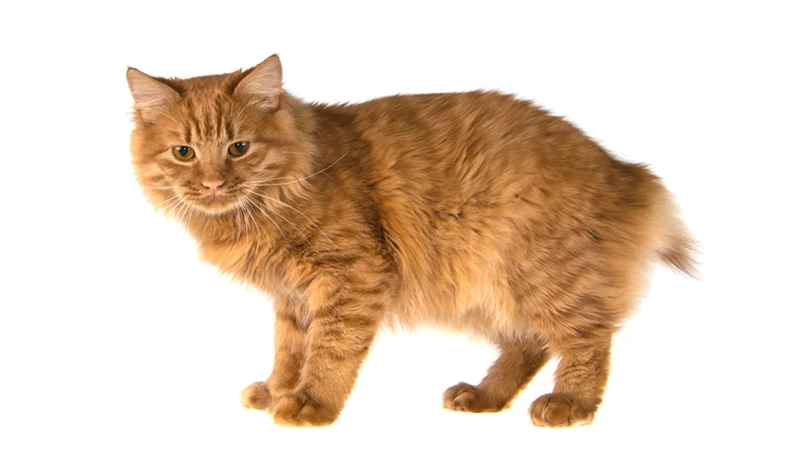
As a proud owner of an American Bobtail, you want to make sure your furry friend is happy and healthy. One essential aspect of maintaining your Bobtail’s well-being is proper grooming, specifically brushing their fur. But where do you even begin? With so many brushes on the market and different techniques to learn, the process can seem overwhelming. Don’t worry! In this comprehensive guide, we’ll walk you through the steps of how to properly and effectively brush your American Bobtail’s fur. So, grab your brush and let’s get started!
What Is an American Bobtail?
The American Bobtail is a unique breed of domestic cat that is known for its distinctive bobbed tail. This breed is native to North America and is known for its strong, muscular build and affectionate personality. American Bobtails are also recognized for their thick, luxurious coats, which come in a variety of colors and patterns.
Physical Characteristics:
- Weight: 7-16 pounds
- Life span: 13-15 years
- Coat: Thick and shaggy
- Tail: Short and bobbed
- Ears: Tipped forward
In addition to their unique physical attributes, American Bobtails are also beloved for their friendly and outgoing personalities. They are known for being social with both humans and other pets and are often compared to dogs in their loyalty and affection.
As with all cats, proper grooming is an essential part of maintaining the health and well-being of American Bobtails. In the following sections, we will explore why brushing is important for their fur and offer tips on how to properly groom this beloved breed.
Don’t forget to check out our article on the best diet for your American Bobtail to keep your cat looking and feeling their best!
Why Is Brushing Essential?
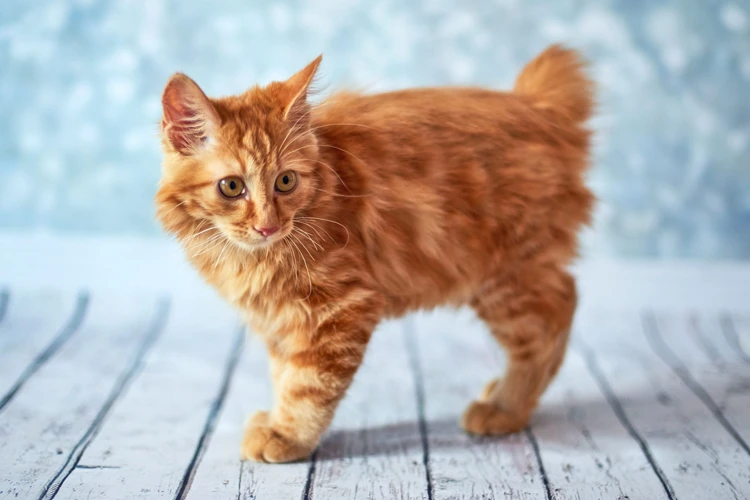
Taking care of your American Bobtail’s coat is essential to their health and comfort. Regular brushing helps maintain the cat’s coat by removing dirt, debris, and loose fur. Without proper grooming, your cat’s fur can become matted and develop knots, causing discomfort and irritation. In this section, we will discuss the importance of brushing your American Bobtail’s fur and the benefits it provides. We’ll also go over how to choose the right brush and how often you should brush your cat’s coat.
Benefits of Brushing
Brushing your American Bobtail’s fur on a regular basis provides several benefits that can keep your pet healthy and happy. Here are some significant advantages of brushing your cat’s fur:
- Removes loose hair: Brushing helps to remove dead hair from your cat’s coat, which reduces the amount of hair your cat sheds throughout your house. Regular brushing also prevents hairballs and matting of hair.
- Improved circulation: Brushing stimulates the skin and improves circulation. By increasing blood flow to the skin’s surface, you can help maintain the skin’s health.
- Distribution of natural oils: A cat’s fur regularly produces natural oils that help protect and condition their skin and fur. Brushing helps spread these oils throughout the fur, ensuring they’re distributed evenly.
- Bonding with your cat: Brushing your cat’s fur is an excellent time to bond and connect with your pet. This quality time can also be used to check your cat for abnormal lumps, bumps, or injuries.
Not only can brushing benefit your cat, but it can also save you time and money in the long run. By reducing shedding and matting, you’ll have less cleaning to do, and your cat will require fewer grooming appointments.
If you’re interested in finding the best tools to help you brush your American Bobtail, check out our article on the 5 best grooming tools for American Bobtail cats. Additionally, to learn more about common fur problems facing bobtail cats and how brushing can help, check out our article on common fur problems and solutions for American Bobtail cats.
How Often Should You Brush?
Regular brushing is crucial in maintaining your American Bobtail’s fur health and appearance. Generally, you should brush your cat’s fur at least once a week to prevent mats and tangles. However, the frequency of brushing may depend on your cat’s fur length and density.
To help you determine how often you should brush your American Bobtail, we have created the following table:
| Fur Length and Density | Brushing Frequency |
|---|---|
| Short, thin fur | Once a week |
| Medium-length, medium-density fur | Every 3-4 days |
| Long, thick fur | Every other day |
Keep in mind that some American Bobtails shed more heavily during seasonal changes, so you may need to brush them more frequently during those times. Regular brushing also allows you to bond with your furry companion, so make it a stress-free and positive experience for both you and your cat.
If you’re unsure of how often to brush your American Bobtail or how to properly brush their fur, consult with a veterinarian or a professional groomer who can guide you on the best practices.
Choosing the Right Brush
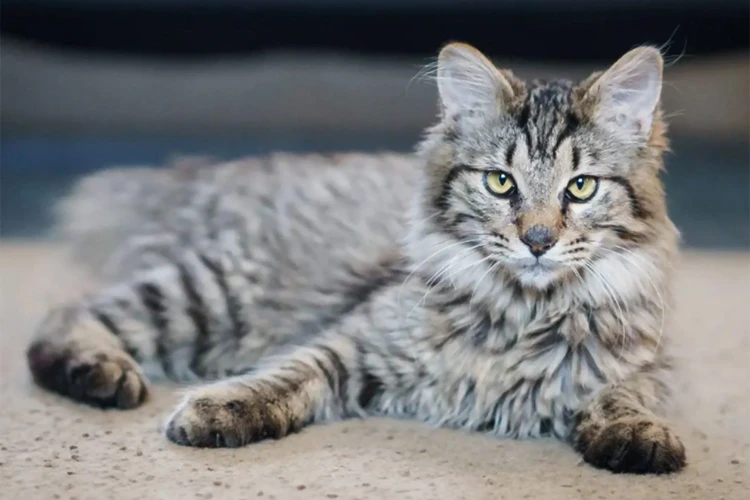
When it comes to grooming your American Bobtail, choosing the right brush can make all the difference in the world. Using the wrong brush can not only be ineffective, but it can also cause discomfort for your furry friend. With so many different types of brushes on the market, it can be difficult to know which one to choose. Let’s explore what factors you should consider when selecting a brush to use on your American Bobtail’s unique fur coat. To learn more about the importance of positive reinforcement when brushing your cat, check out our article on positive reinforcement brushing for American Bobtails.
Fur Length and Brush Type
Fur Length and Brush Type
When it comes to grooming your American Bobtail, the length of their fur will determine the type of brush you should use. A high-quality brush is a must-have tool for keeping your pet’s coat in optimal condition.
Different types of brushes have unique features that suit different coat lengths and types. Here is a table to help you choose the best brush for your American Bobtail based on its fur length.
| Fur Length | Brush Type | Description |
|---|---|---|
| Short | Slicker Brush | A flat brush with fine, short wires that are gentle on your cat’s skin. |
| Medium | Undercoat Rake | A rake with long, thick teeth that can reach through the outer layer of fur to remove dead undercoat hair. |
| Long | Wide-Tooth Comb | A comb with widely spaced teeth that prevent tangling and matting. |
It is important to note that some American Bobtails may have a mix of fur lengths. In such cases, you may want to use different types of brushes for different areas of your cat’s body. Always choose a brush that is appropriate for your cat’s fur length to prevent irritation and skin damage.
Using the right brush type can make all the difference in maintaining your American Bobtail’s coat. Be sure to brush your cat regularly and with care to keep their fur healthy and shiny. For more information on detangling mats and knots or how brushing compares to bathing, please see our guide on detangling American Bobtail fur or our article on brushing versus bathing American Bobtails.
Comfort and Grip
When choosing the right brush for your American Bobtail, it’s important to consider both comfort and grip. These factors can greatly impact the effectiveness of your brushing sessions, as well as the overall experience for both you and your furry friend.
Comfort: Look for brushes with soft bristles or teeth, as these are gentle on your cat’s skin and won’t cause discomfort or irritation. Additionally, consider the shape of the brush and how it will fit in your hand. Some brushes have ergonomic handles designed for comfortable use, while others may be too bulky or awkward to hold for extended periods.
Grip: The grip of your brush is also important for ensuring that you can effectively remove loose fur and mats from your American Bobtail’s coat. Look for brushes with non-slip handles or textured grips, as these will give you more control and prevent slipping or dropping the brush during use. Brushes with adjustable handles can also be helpful for finding the perfect grip for your hand size.
A brush that is both comfortable and easy to grip will make the brushing process much more enjoyable for you and your American Bobtail. With the right tool in hand, you can ensure a smooth and enjoyable brushing experience that helps keep your cat’s coat healthy and beautiful.
To learn more about how to brush your American Bobtail’s fur, check out our step-by-step guide. Additionally, if you’re still not sure which brush to use, our article on Brushing Your American Bobtail Cat provides more in-depth information on choosing the right brush for your cat’s specific needs.
Preparing Your Bobtail for Brushing
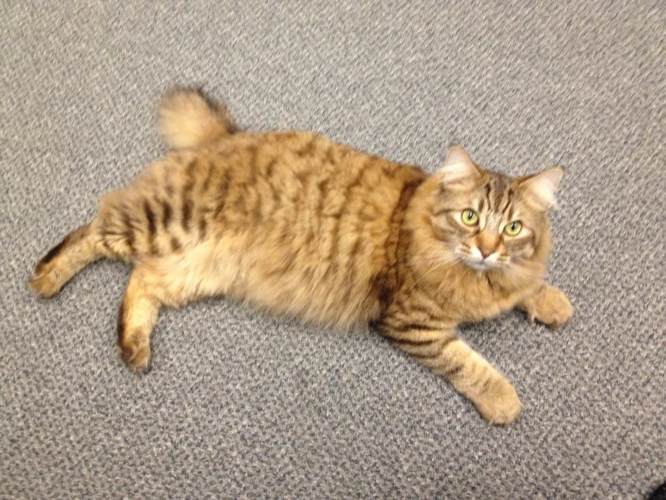
As much as your American Bobtail needs regular brushing to keep its coat healthy, it’s also important to prepare your furry friend for the process beforehand. Contrary to popular belief, proper preparation can make brushing a comfortable and pleasant experience for both you and your pet. In this section, we’ll share some insightful tips and tricks that will help you prepare your Bobtail for brushing like a pro.
Behavioral Considerations
Properly brushing your American Bobtail’s fur is not only important for their hygiene and appearance, but it can also be a bonding experience for you and your furry friend. However, before starting the brushing process, there are some behavioral considerations to keep in mind.
| Consideration | Guidance |
|---|---|
| Choose the right time | Make sure your Bobtail is calm and relaxed before beginning the brushing process. Choose a time when they are not too energetic or hungry. |
| Introduce the brush slowly | Let your Bobtail sniff and examine the brush before use. Gently touch their fur with the brush to get them used to the sensation. |
| Reward good behavior | Use positive reinforcement, such as treats or praise, to reward your Bobtail for good behavior during the brushing process. This will help them associate grooming with positive experiences. |
| Be gentle and patient | Use a soft touch and avoid pulling or tugging on mats or knots. If your Bobtail becomes agitated or uncomfortable, take a break and resume brushing later. |
| Check for signs of discomfort | Watch for signs that your Bobtail is uncomfortable, such as vocalizations or twitching. This may indicate that you are brushing too hard or in a sensitive area. Adjust your technique accordingly. |
By keeping these behavioral considerations in mind, you can help ensure that the brushing process is a positive and stress-free experience for both you and your American Bobtail. Remember to be patient, gentle, and provide plenty of positive reinforcement along the way.
Detangling Mats and Knots
Mats and knots can be an issue in American Bobtail’s fur, especially if their coat is long. It’s important to carefully detangle these areas to prevent any discomfort or potential skin problems for your feline friend. Here are some helpful tips for detangling mats and knots:
- Start Small: Begin by gently pulling apart tiny mats and knots with your fingers or a comb. This will help to prevent any discomfort or pain for your American Bobtail.
- Use Moisturizing Sprays: Apply a moisturizing spray or detangling solution to the affected areas, allowing the solution to soak in for several minutes. This can help to soften and loosen the tangles, making them easier to comb out.
- Use a Wide-Tooth Comb: When combing out mats and knots, it’s important to use a wide-tooth comb to prevent further pulling or damage to your Bobtail’s fur.
- Start from the Bottom: When combing out mats, start at the bottom of the mat and work your way up, slowly and carefully working through the tangles. This will help to prevent any pain or discomfort for your American Bobtail.
- Be Patient: Detangling mats and knots can take time, so it’s important to be patient and not rush the process. Rushing can lead to further damage to your Bobtail’s coat and can be uncomfortable for your cat.
- Trim if Necessary: If you encounter mats that are too difficult to detangle, it may be necessary to trim them with scissors or clippers. It’s important to be very careful when using sharp instruments around your cat to avoid causing any harm.
By following these tips, you can ensure that your American Bobtail’s fur stays healthy and free of mats and knots. Remember to be patient and gentle throughout the detangling process, and your cat will thank you with a healthy, shiny coat.
The Brushing Process
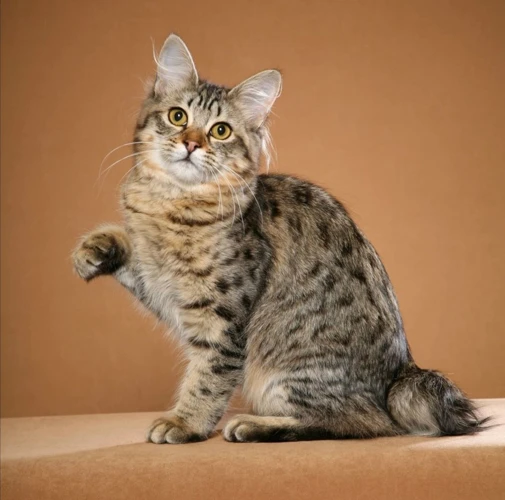
Now that you have prepared your American Bobtail for brushing, it’s time to dive into the actual brushing process. Brushing your cat’s fur may sound simple, but it’s a crucial aspect of their overall health and hygiene. Plus, it’s an excellent bonding opportunity between you and your furry friend. In this section, we will show you a step-by-step guide on how to properly brush your American Bobtail’s coat, as well as provide additional tips to make the process as easy as possible. So, grab your brush and let’s get started!
Step-by-Step Guide
To properly brush your American Bobtail’s fur, follow this step-by-step guide:
| Step 1: | Start by gently combing through your cat’s fur using a brush with wide-set bristles. This will help remove any loose dirt or debris. |
| Step 2: | Once your cat is comfortable with the initial combing, switch to a brush with closer-set bristles to remove any tangles or mats. |
| Step 3: | Work in sections, starting from the head and moving towards the tail. Be sure to brush in the direction of hair growth to prevent discomfort for your cat. |
| Step 4: | Pay special attention to high-shedding areas, such as the chest and belly. Use a small slicker brush to remove any loose undercoat. |
| Step 5: | If you encounter a knot or mat, use a detangling spray and a comb to gently work it out. Avoid pulling or cutting the fur, as this can cause discomfort or injury to your cat. |
| Step 6: | Once you’ve finished brushing, reward your cat with a treat or some playtime to reinforce positive behavior during grooming sessions. |
Remember to take your time and be gentle during the brushing process to ensure your American Bobtail stays comfortable and happy.
Focusing on High-Shedding Areas
When brushing your American Bobtail, it is essential to focus on the high-shedding areas to maintain their coat’s luster and longevity. Here are the high-shedding areas that require extra attention during the brushing process:
- Undercoat: Start by brushing the undercoat, which is the soft and dense fur layer, using a wide-toothed comb or slicker brush. This area is a common hiding spot for mats and tangles, so be gentle to avoid hurting your cat while untangling any knots.
- Back and Sides: These areas tend to have medium-length fur and are more prone to shedding, so brush them regularly using a slicker brush. Pay special attention to the areas above the tail and around the hips, as mats tend to form there.
- Belly and Legs: Brush the belly and legs using a soft-bristled brush or a comb. These areas have sensitive skin, so avoid using a slicker brush or brushing too aggressively.
- Neck and Chest: Use a slicker brush or a comb to brush your cat’s neck and chest areas. These areas are prone to mats and tangles, so be extra gentle and thorough.
Remember to be gentle and patient when brushing your American Bobtail’s high-shedding areas. Rushing or brushing too hard can cause discomfort or pain to your cat, which may lead to behavioral problems during grooming sessions. By focusing on high-shedding areas during brushing, you are promoting a healthy and glowing coat while bonding with your feline friend.
Common Mistakes to Avoid
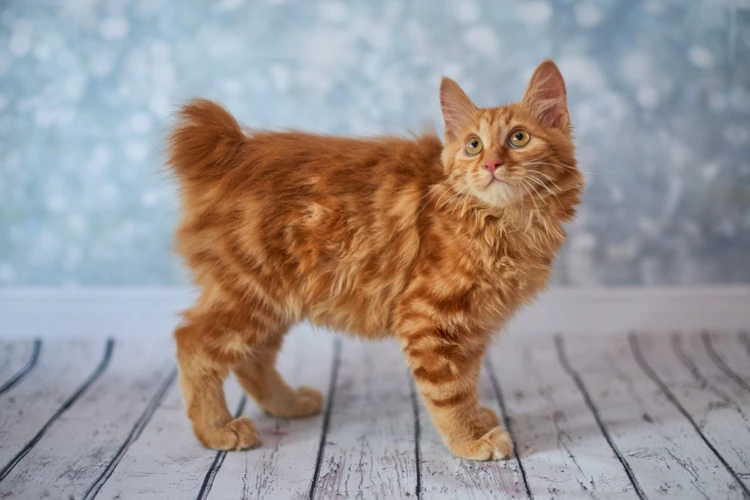
Keeping an American Bobtail’s fur in pristine condition is no easy feat, especially for novice pet owners. When it comes to brushing your beloved feline’s fur, there are several common mistakes that every pet owner should avoid. These errors can lead to more harm than good, causing discomfort to your furry friend and undoing all your hard work. To help ensure the health and happiness of your American Bobtail, we’ve compiled a list of common mistakes to avoid when brushing their fur. Keep reading to find out how to steer clear of these mistakes and have a happy, healthy, and well-groomed feline friend.
Brushing Too Hard
When brushing an American Bobtail’s fur, it’s important to avoid brushing too hard. If you apply too much pressure or roughness, you risk damaging their sensitive skin and causing discomfort or even pain. Here are some tips to prevent brushing too hard:
- Start with a soft brush: It’s always a good idea to start the brushing process with a soft brush. This will help you get a sense of your cat’s level of tolerance for brushing, and you can adjust your technique from there.
- Use gentle strokes: When brushing, use smooth, gentle strokes rather than forceful brushing. You can hold the brush softly, while gently running it through their coat in the direction of hair growth.
- Pay attention to your cat’s body language: Your cat may give you signs if they feel uncomfortable or if your brushing is too hard. Watch for signs such as flinching, tensing or vocalizing discomfort. If you notice these signs, stop brushing and try again after your cat has relaxed.
- Be careful around sensitive areas: Certain areas of your cat’s body may be more sensitive than others, such as around their ears or belly. Be extra gentle and cautious when brushing these areas.
- Don’t rush the process: Brushing your cat’s fur should be a slow and deliberate process. Taking your time and applying a gentle touch is key to avoiding causing discomfort.
Remember: Brushing your American Bobtail’s fur should be an enjoyable experience for both you and your cat. Take your time, use a gentle touch, and be observant of your cat’s behavior and body language. By doing so, you’ll help keep their coat healthy and enhance the bond between you and your feline friend.
Skipping Sessions
One common mistake that cat owners make is skipping brushing sessions. While it may seem like an innocent slip-up, the consequences of neglecting your American Bobtail’s fur can be severe. Here are some reasons why you shouldn’t skip brushing sessions:
- Matting: Without proper brushing, your cat’s fur can become tangled and matted, which can be painful and uncomfortable for your kitty. Over time, mats can become too tight and pull on your cat’s skin, potentially leading to infection or injury.
- Shedding: Brushing is essential for removing loose hair and preventing shedding. If you skip brushing sessions, your cat’s hair can accumulate, causing tangles and mats, and leading to a greater shedding problem than you started with. This can result in cat hair all over your home, leading to extra cleaning time and potential allergies.
- Hygiene: As a cat grooms themselves with their tongue, they may inadvertently swallow fur, which can lead to hairballs. Brushing your cat’s fur helps to remove loose hairs and prevent hairballs from forming, ensuring that your cat’s digestive system stays healthy.
By brushing your American Bobtail’s fur consistently, you can keep them healthy and keep your home clean. Don’t let busy schedules or forgetfulness stand in the way of proper cat care. Set reminders or establish a routine that works for both you and your feline friend to ensure that brushing sessions aren’t skipped.
Additional Coat Maintenance Tips
Maintaining your American Bobtail’s coat is an essential element of your pet’s overall care. In addition to regular brushing, there are several other coat maintenance tips that you should keep in mind to help keep your Bobtail healthy and comfortable. Below, we will discuss some critical tips that you should follow, including bathing and trimming nails and fur. These grooming techniques can help keep your pet’s coat in top condition and prevent any potential health issues, ensuring that your Bobtail looks and feels its best.
Bathing Your Bobtail
Maintaining your American Bobtail’s coat doesn’t stop at brushing. Regular bathing ensures that their fur stays clean, healthy, and free from pests. However, it’s important to note that over-bathing can strip their coat of natural oils, leading to skin irritation and other issues. So, how often should you bathe your Bobtail? It depends on their activity level, environment, and skin condition. Generally, once every three to six months is sufficient.
When it’s time for a bath, start by gathering all the necessary supplies. This includes a cat-friendly shampoo, a jug or showerhead for rinsing, towels, and a brush. Fill up a sink or bathtub with lukewarm water, and gently place your Bobtail inside.
TIP: Use a rubber mat at the bottom of the sink or bathtub for extra grip and comfort.
Wet their coat thoroughly, being careful not to get water in their eyes, ears, or nose. Apply a small amount of shampoo, and lather it evenly all over their body, focusing on areas that are particularly dirty or oily. Rinse thoroughly, making sure to remove all the soap suds.
TIP: Use your hand or a cloth to gently massage their skin as you shampoo, to promote blood circulation and relaxation.
After the final rinse, gently pat your Bobtail dry with a towel. Avoid rubbing their fur too vigorously, as this can cause damage and tangling. Instead, use a brush to detangle any knots and mats, and to restore their coat’s natural shine.
TIP: If your Bobtail has long fur, consider using a pet dryer to speed up the drying process and prevent chill. Make sure to use the lowest heat setting and keep the dryer at a safe distance from their skin.
Finally, reward your Bobtail with a treat or a play session to reinforce the positive experience. And remember, your cat’s comfort and well-being should always come first. If they show signs of distress or discomfort during the bathing process, stop immediately and consult with your veterinarian.
Trimming Nails and Fur
Maintaining the coat of your American Bobtail is not limited to brushing. Trimming your feline’s nails and fur will help keep your pet comfortable and healthy. Here are tips on how to trim your Bobtail’s nails and fur:
Nail Trimming:
- Choose a quiet and cozy area where you both feel comfortable.
- Hold your Bobtail close to you and gently secure its paw in your hand.
- Use a sharp cat nail clipper to trim the tip of each nail, avoiding the pink part, called the quick, which contains blood vessels and nerves. Trimming the quick can cause pain and bleeding.
- If you accidentally nick the quick, apply some styptic powder or cornstarch to stop the bleeding.
- Reward your Bobtail with treats and praise after each paw is trimmed to create a positive experience.
Fur Trimming:
- Use sharp and high-quality scissors suitable for cat fur trimming.
- Trim only the fur that is excessively long and prone to matting, such as around the ears and rear end. Avoid trimming fur that protects the skin from sunburn, cold, and insects.
- Gently brush the fur before and after trimming to ensure you are only trimming the desired area and to avoid cutting the skin.
- Trim in a well-lit area and watch out for sudden movements by your Bobtail. You may need an additional person to help you keep your feline calm and still during trimming.
Trimming your cat’s nails and fur can be a daunting task to both you and your Bobtail. It may take time to get used to, but with patience, practice, and the right tools, it becomes easier. If you’re unsure about trimming your Bobtail’s nails and fur, ask your vet or a professional groomer for guidance.
Conclusion
In conclusion, brushing your American Bobtail’s fur is essential to keep their coat healthy and shiny, and it is also a good opportunity to bond with your precious feline. By following the proper brushing techniques and using the right tools, you can make sure that your cat looks his or her best at all times.
Remember, brushing should be a positive experience for both you and your cat, so it’s important to take time to prepare your Bobtail for brushing, detangle any mats or knots, and go slow and gentle while brushing. And by maintaining a regular brushing schedule, you can minimize any potential shedding and reduce the risk of hairballs.
Additionally, don’t forget to give your cat regular baths and trim their nails and fur as needed. By taking care of all aspects of your Bobtail’s coat maintenance, you can ensure that your furry friend is happy, healthy, and comfortable.
So take the time to show your American Bobtail some love and attention through proper brushing and grooming, and your cat will thank you with purrs and snuggles. Happy brushing!
Frequently Asked Questions
How often should I brush my American Bobtail?
You should ideally brush your American Bobtail at least once a week to prevent mats and keep their coat healthy and shiny.
What type of brush is best for American Bobtails?
The best brush for an American Bobtail will depend on their coat length and texture. A slicker brush is generally recommended for most Bobtails.
How do I properly detangle mats in my Bobtail’s fur?
Use a mat splitter or mat rake to carefully and gently loosen the tangled fur before using a slicker brush to smooth it out.
Can I use human shampoo to bathe my American Bobtail?
No, human shampoo is not recommended for bathing cats as their skin has a different pH level than humans. Use a cat-specific shampoo.
How can I make brushing more enjoyable for my Bobtail?
Offer treats and praise during and after brushing sessions to make it a positive experience for your cat. You can also try using a grooming glove for a gentler touch.
Is it necessary to groom a Bobtail’s undercoat?
Yes, it is important to groom your Bobtail’s undercoat to prevent matting and keep their fur healthy. Use a slicker brush or undercoat rake to remove loose fur.
Should I clip my Bobtail’s fur during the summer months?
It is not necessary to clip your Bobtail’s fur during the summer. Their coat is designed to regulate body temperature, but you can use a slicker brush to remove any loose undercoat.
Can I use a flea comb to brush my Bobtail?
Yes, a flea comb can be used to remove dead fur and dirt from your Bobtail’s coat, but it may not be as effective as a slicker brush for preventing mats.
Do I need to trim my Bobtail’s nails before brushing?
You don’t need to trim your Bobtail’s nails before brushing, but it’s a good idea to trim them regularly to prevent them from getting too long and sharp.
What should I do if my Bobtail doesn’t like being brushed?
If your Bobtail doesn’t enjoy being brushed, try using a grooming glove or a different type of brush. Offer treats and praise to help make the experience more positive for your cat.

